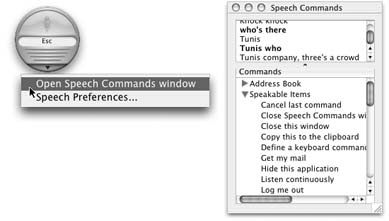Speech Recognition
Although it may surprise many Mac users, the Mac is quite talented when it comes to speech. Its abilities fall into two categories: reading text aloud, using a synthesized voice; and taking commands from your voice.
The Apple marketing machine may have been working too hard when it called this feature "speech recognition"—the Mac OS feature called PlainTalk doesn't take dictation, typing out what you say. (For that, you need a program like ViaVoice for Mac OS X, www.scansoft.com, or iListen, www.macspeech.com.)
Instead, PlainTalk is what's known as a command-and-control technology. It lets you open programs, trigger AppleScripts, choose menu commands, trigger keystrokes, and click dialog box buttons and tabs—just by speaking their names.
Few people use PlainTalk speech recognition. But if your Mac has a microphone, PlainTalk is worth at least a 15-minute test drive. It may become a part of your work routine forever.

Figure 15-12. Left: The Feedback window lacks the standard Close and Minimize buttons. If it's in your way, just double-click it (or say "minimize speech window") to shrink it into your Dock. If you choose Speech Preferences from its bottom- edge triangle, you open the Speech preferences window. Right: Choosing Open Speech Commands window, of course, opens the list of things you can say.
Your First Conversation with the Mac
The on/off switch for speech recognition ...
Get Mac OS X: The Missing Manual, Tiger Edition now with the O’Reilly learning platform.
O’Reilly members experience books, live events, courses curated by job role, and more from O’Reilly and nearly 200 top publishers.

